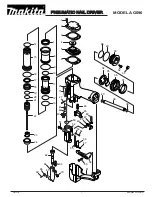
GENERAL
W
ARNING
GENERAL W
ARNING
Tool Handling
•
Only persons who have read and understood the tool operating/safety instruction should
operate the tool.
•
Always assume that the tool contains fasteners.
•
Do not point the tool toward yourself or anyone, whether it contains fasteners or not.
•
Keep bystanders and children away while operating tool.
•
Do not actuate tool unless tool is placed firmly against the workpiece.
•
Stay alert, focus on your work and use common sense when using the tools.
•
Do not use the tool while tired, after having consumed drugs or alcohol, or while under the
influence of medication.
•
Do not overreach. Keep proper footing and balance at all times.
•
Do not hold or carry the tool with a finger on the trigger.
•
Drive fasteners into proper work surface only.
•
Do not drive fasteners into other fasteners.
•
After driving a fastener, the tool may spring back (recoil), causing it to move away from the
work surface. To reduce risk of injury, manage recoil by:
-
Always maintaining control of tool.
-
Allowing recoil to move tool away from the work surface.
-
Not resisting recoil in such a way that the tool will be forced back into the
work
surface.
-
Keeping face and body parts away from tool.
•
When working close to an edge of a workpiece or at steep angles, use care to minimize
chipping, splitting or splintering, or free flight or ricochet of fasteners, which
may cause injury.
•
Keep hands and body away from fastener discharge area of tool.
•
Do not load tool with fasteners when any one of the operating controls is activated.
•
Do not operate tool with any power source other than that specified in tool
operating/safety
instructions.
•
Do not operate tool with any operating pressure other than that specified in tool
operating/safety
instructions.
•
Always select an actuation system that is appropriate to the fastener application and
the training of the operator.
•
Use extra caution when driving fasteners into existing walls or other blind areas to prevent
contact with hidden persons or objects on other side (e.g. wires, pipes)
•
Remove the fuel cell and battery when:
-
Not in use
-
Performing any maintenance or repairs
-
Clearing a jam
-
Elevating, lowering or otherwise moving the tools to a new location
-
Tool is outside of the operator’s supervision or control
-
Removing fasteners from the magazine
3
delfast.com
Summary of Contents for NAC-CN90
Page 15: ...13 delfast com CORDLESS HOW TO...


































